Persian Garden: Iran Hidden Havens

Persian Gardens stand as breathtaking symbols of Iran’s rich history and cultural legacy. These gardens, with their unique designs and lush vegetation, offer a serene escape from the hustle and bustle of city life.
As you step into a Persian Garden, you enter a world where nature and architecture blend seamlessly. Each garden tells a story of ancient traditions and artistic expression, rooted deeply in Persian culture.
In this article, we explore the diversity and beauty of these gardens, showcasing their role as peaceful havens and cultural landmarks in Iran.
In 2011, a collection of nine Iranian gardens was inscribed by UNESCO as a serial nomination under the title ‘The Persian Garden’.
Join us in discovering the hidden oases of Iran – where history, nature, and art come together in perfect harmony.
Except Abbasabad in Mazandaran province, the rest are all located in the arid and semi arid areas of central plateau of Iran, and that makes the creation of the garden, a “masterpiece of human creative genius” as UNESCO describes it. These nine gardens are a small selection to represent design, engineering and meaning of a Persian Garden.
Contents
Persian Gardens – A paradise on earth
You can experience the paradise-like feeling of the garden when being under the scorching sun for some time. As soon as you cross the gate and pass the garden walls, you will notice the freshness of air, cool temperature under the shade, loving touch of the green and pleasant and gentle sound of water. No wonder Persian Garden represents Paradise.
The term pairidaēza which comes from Avesta, the holy book of Zoroastrian people, means garden. The same word has traveled through time and place to become the word Paradise in English, Paradies in German and paradis in French.
Ferdos: Garden of Eden
The term ‘Ferdos,’ reflecting both the Garden of Eden and the highest level of heaven in Muslim belief, connects deeply with the concept of gardens. This term symbolizes gardens fed by four rivers or a single river branching into four, embodying a paradise on earth.
Same description applies to definition of Persian Garden, a surrounded land divided to four sections (Char-bagh) by four aqueducts.
UNESCO listed Persian gardens
| Name of Garden | City | Era |
|---|---|---|
| 1. Pasargadae | Pasargad County | 6th century BC |
| 2. Chehel Sotoun | Isfahan | 17th century |
| 3. Fin Garden | Kashan | 16th century |
| 4. Eram Garden | Shiraz | 13th century |
| 5. Shazdeh Garden | Mahan | 19th century |
| 6. Dowlatabad Garden | Yazd | 18th century |
| 7. Abbasabad Garden | Behshahr | 16th century |
| 8. Pahlavanpour Garden | Mehriz | 19th century |
| 9. Akbarieh Garden | Birjand | 19th century |
1. Pasargadae Garden
The Persian Garden’s history dates back to Cyrus the Great’s Achaemenid era, with the first known royal garden believed to be in Pasargadae, near modern-day Shiraz.
The archaeological site of Pasargadae Garden is among the inscribed gardens, although there are no trees remaining.

Water plays very important roles in the Persian Garden. Not only it is for irrigation, but it giving the aesthetic beauty by flowing in the well designed aqueducts, jetting into fountains and pouring small ponds. Water is always moving, it should not be still, it ought to give life to plants, freshen the air and create the burbling sound that soothes the soul.
Interestingly, the water used for irrigating Persian Gardens often comes from a different source than the water used for ornamental purposes. After nurturing the garden, it flows out for use elsewhere, showcasing efficient and thoughtful water management.
2. Chehel Sotoun Garden in Isfahan
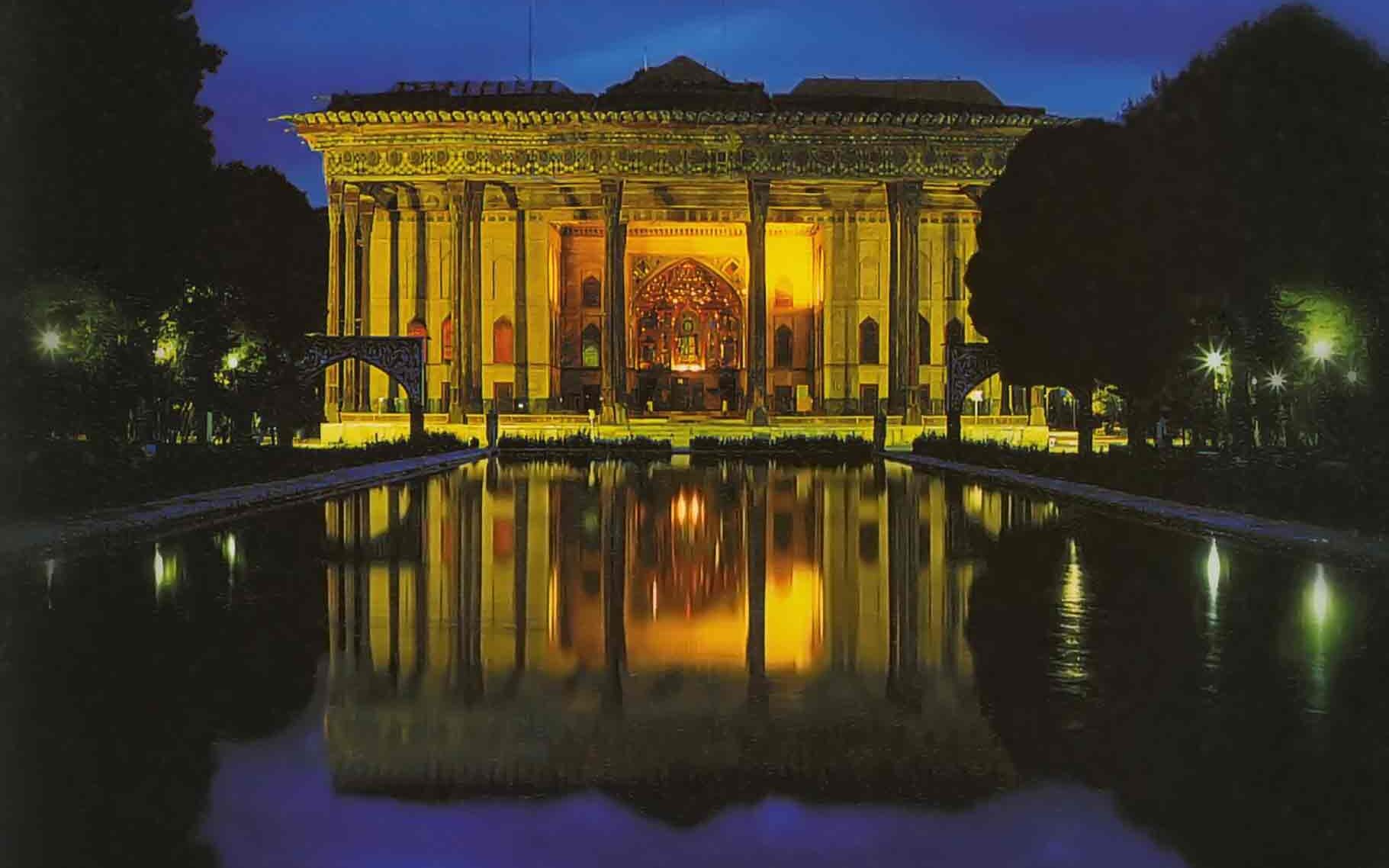
Chehel Sotoun Garden, located in Isfahan, Iran, stands as an exceptional example of Persian garden design and royal architecture, reflecting the peak of Persian cultural and artistic achievement in the 17th century.
The historic Chehel Sotoun palace and garden, known as “Forty Columns,” boasts a remarkable reflection pool. When filled, this pool creates an illusion of the palace having forty columns, while in reality, there are only twenty.
This doubling effect adds to the site’s allure. Built initially as a pleasure pavilion and reception hall by Shah Abbas II, Chehel Sotoun is famous for its stunning frescoes and murals. These artworks vividly portray historical events and aspects of courtly life, making the palace a treasure trove of Persian art and history.
The Chehel Sotoun Garden exemplifies the classical Persian concept of a paradise garden, designed to symbolize the mythical Garden of Eden. The layout, harmoniously blending nature and architecture, creates a tranquil and meditative environment. The garden’s landscaping includes long, narrow waterways that guide visitors’ attention towards the majestic pavilion, while tall plane trees and floral beds add to its serene beauty.
3. Fin Garden in Kashan
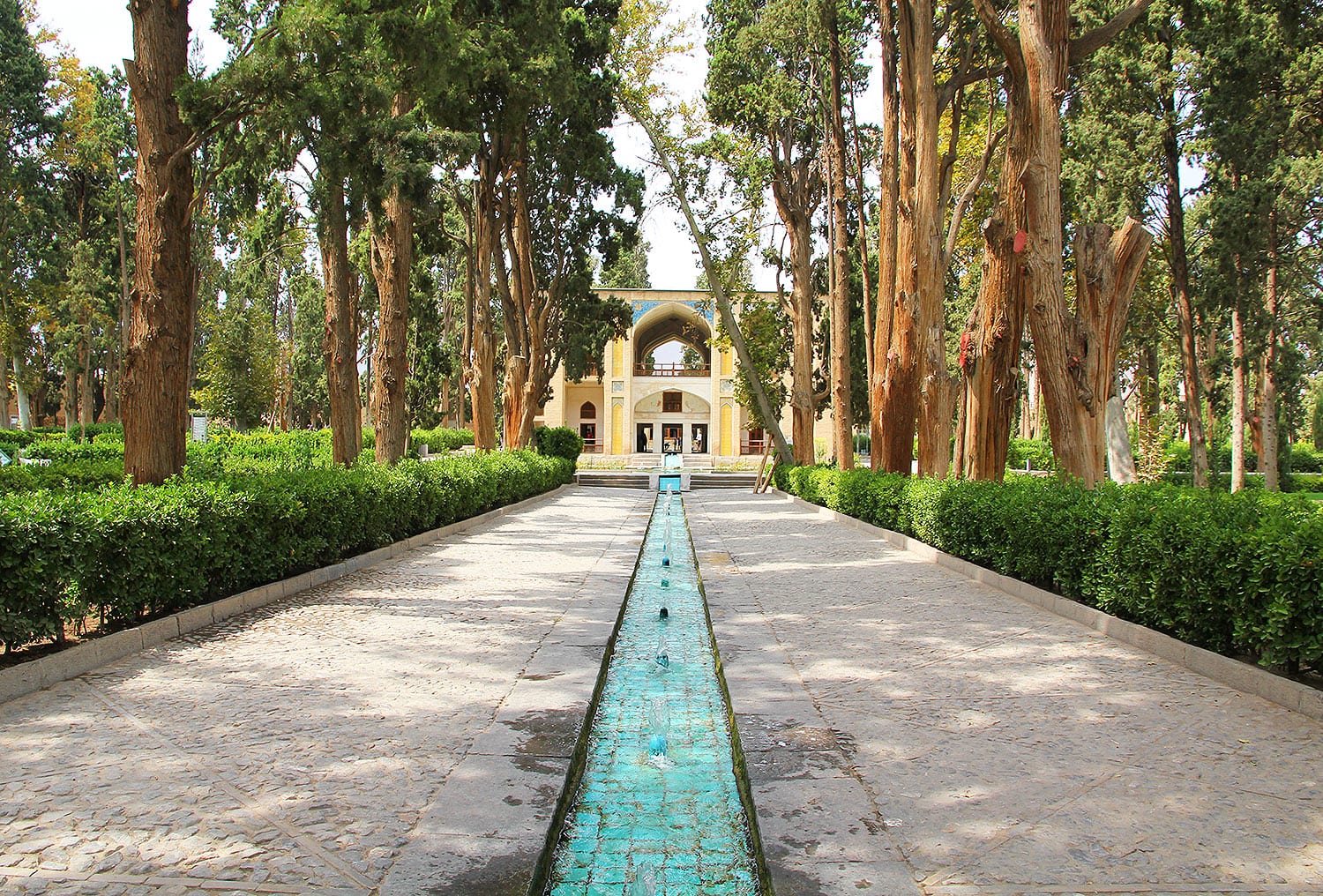
The Fin Garden in Kashan holds the title of the oldest existing royal garden in Iran, completed in 1590.
The Fin Garden sterling example of the celebrated Persian gardens that have earned recognition as UNESCO World Heritage Sites. Known locally as Bagh-e Fin, this historic garden, established during the Safavid era in the 16th century, is one of the oldest extant gardens in Iran.
Its design perfectly embodies the Persian garden principles, characterized by water channels, fountains, and lush greenery, creating a visual and sensory oasis in the midst of arid surroundings.
The central feature of the garden is a series of symmetrically arranged pools, fed by natural springs. Intricate tile work, refined architectural details, and the use of water elements reflect the ingenuity and artistic finesse of the Persian culture.
Fin Garden is more than just a place of natural beauty; it has also played a significant role in Iranian history. It was the location of the tragic assassination of the famous Persian statesman, Amir Kabir, in 1852, which adds a layer of historical significance to the site.
The garden’s architecture, including its kiosks and pavilions, merges seamlessly with the natural landscape, symbolizing the harmonious interaction between humans and nature, a key concept in Persian garden design. As a UNESCO World Heritage Site, Fin Garden is not only a testament to Iran’s rich artistic heritage but also serves as a cultural bridge, inviting people from all over the world to explore and appreciate the depth and beauty of Persian garden design. Its preservation allows a glimpse into the sophisticated urban planning and aesthetic preferences of ancient Persian society.
4. Shazdeh Garden in Kerman

Shazdeh Garden in Mahan near Kerman is built on a slope, so that water can flow easily. Fountains outburst naturally by force of gravity. Shazdeh Garden is also known as one of the most beautiful of Persian gardens.
Garden planners, had special knowledge of architecture, hydrology, and gardening. Trees, flowers and shrubs were chosen based on their beauty, produce and shade. Many of the trees hold a symbolic meaning, such as Cypress which represents unrestrained and pride or Plane tree which represents eternal blessing of gods and spirits. Also every garden ought to have fruit trees, to please the guests with abundance of Persian hospitality.
Chehel Sotun Garden, famous for its name (forty columns), is located in Isfahan. The pavilion in fact has 20 wooden columns but the reflection of the building on the surface of water makes the name legitimate.
Almost all Persian Gardens have an elaborate pavilion built on the main axis, creating the symmetrical image of the garden. The pavilion itself represents the skillfulness of the architect and the builders. The fabulous design of interconnected rooms decorated with astonishing tilework and Orsi (stained glass windows) can blow your mind. You can picture the feasts and banquets took place in such beautiful, pleasant and relaxing heaven.
5. Eram Garden in Shiraz

Eram Garden in Shiraz, a distinguished example of Persian gardens and a UNESCO World Heritage Site, has a rich and varied history that spans across different eras and cultures. For nearly 70 years, it served as the residence of the Khans of the Qashqai nomads, a testament to the garden’s significance in Iranian social and political history. This period in the garden’s history highlights its role not just as a place of beauty and leisure, but also as a center of power and influence in the region.
BOOK ONLINE
Tehran Hotels
The architectural highlight of Eram Garden is its exquisite pavilion, which was constructed during the Qajar dynasty. Despite its Qajar-era origins, the pavilion notably adheres to the architectural style of the earlier Zand era, showcasing a blend of design elements from different periods. This fusion of styles in the pavilion’s architecture adds to the historical and aesthetic value of the garden, illustrating the evolution of Persian architectural trends over time. The building is adorned with intricate tile work, elegant columns, and stunning frescoes, creating a visually striking centerpiece within the lush greenery of the garden.
6. Akbarieh Garden in Birjand
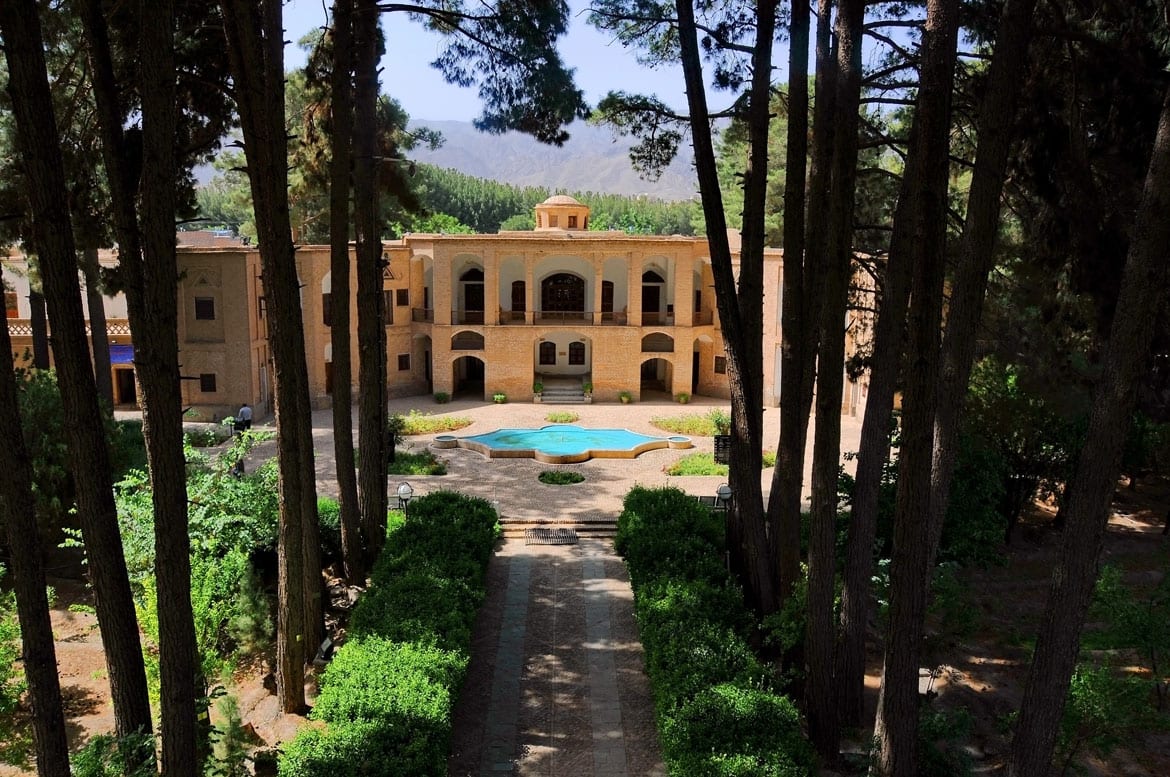
Akbarieh Garden, located in the historical city of Birjand in South Khorasan province, stands as a unique emblem of Persian garden design, distinguished notably for its blend of Iranian and Russian architectural influences. Registered as a UNESCO World Heritage Site, this garden is a testament to the cultural exchanges and artistic syntheses that have shaped Iran’s history. The garden is celebrated for its towering and magnificent pine trees, which add a distinct character and grandeur to its landscape. These pine trees not only enhance the garden’s aesthetic appeal but also contribute to the serene and tranquil atmosphere, making it a haven of natural beauty.
The architectural centerpiece of Akbarieh Garden is its splendid pavilion, which showcases an intriguing fusion of Iranian and Russian styles, a feature that sets it apart from other Persian gardens. This unique blend is evident in the intricate designs, motifs, and structural elements of the pavilion, reflecting a cross-cultural dialogue between the two regions. The pavilion serves not only as a focal point of beauty but also as a symbol of the historical connections and artistic innovations that have occurred in this region.
7. Pahlavanpour Garden in Mehriz
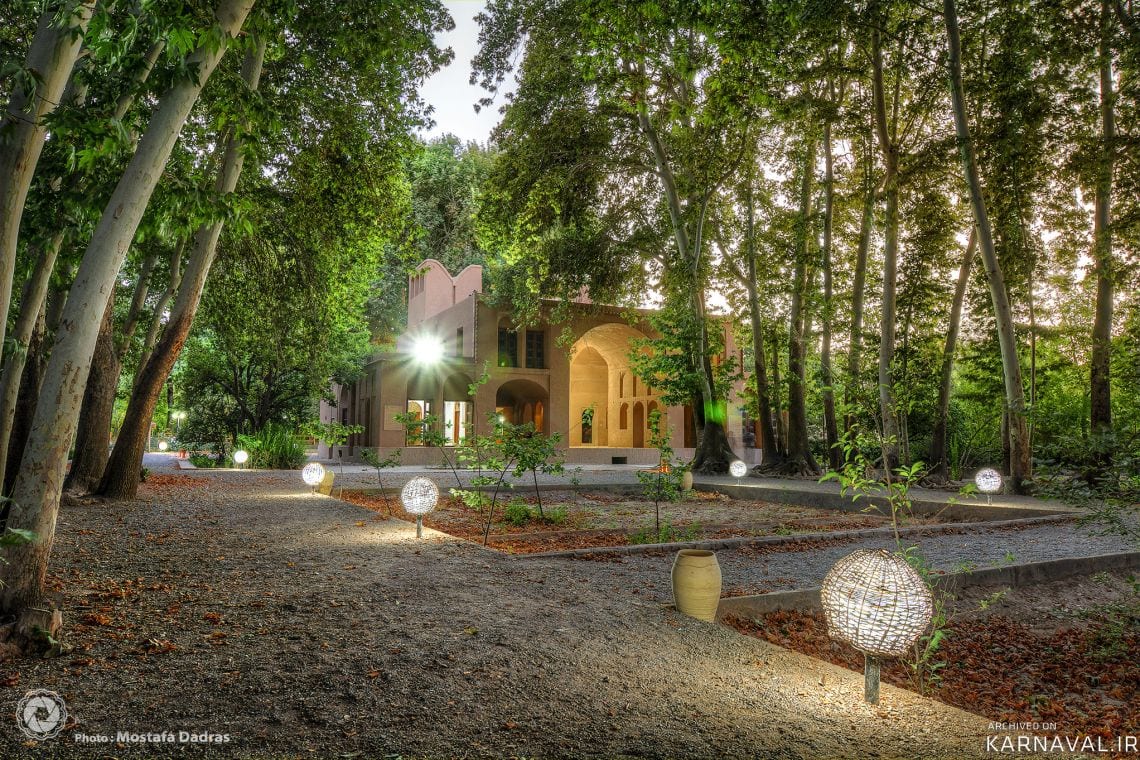
Pahlavanpour Garden in Mehriz stands out among the Persian gardens inscribed as UNESCO World Heritage Sites for its unique historical background and distinctive water management system. Unlike most other famous Persian gardens that were commissioned by rulers and royal families, Pahlavanpour Garden was owned by a prominent businessman. This fact alone marks it as an exceptional example within the Persian garden tradition, as it reflects the broader social and economic history of Iran, beyond the confines of royal or governmental initiatives. The garden, with its lush vegetation, elegant design, and tranquil ambience, showcases the exquisite taste and wealth that could be achieved by successful individuals in Persian society.
A remarkable aspect of Pahlavanpour Garden is its sophisticated water system, which utilizes two different sources for aesthetic and irrigation purposes. This innovative approach to water management not only highlights the ingenuity of Persian garden designers but also underscores the importance of water in these arid regions. The aesthetic water features, such as fountains and streams, create a serene and visually appealing environment, while a separate, more practical system ensures efficient irrigation of the garden’s vegetation. This dual water system reflects a deep understanding of and respect for the precious resource of water, integrating functionality with beauty. The garden’s lush greenery, contrasted with its desert surroundings, stands as a testament to the skillful and sustainable use of water, making Pahlavanpour Garden a significant cultural and ecological site. Its preservation and recognition by UNESCO help to illustrate the diversity within Persian garden designs and the broader cultural narratives they represent.
8. Dowlatabad Garden in Yazd

Dowlatabad Garden in Yazd, a UNESCO World Heritage Site, is one of the most famous and revered Persian gardens, known for its distinctive features and adaptation to the arid environment of the region. Established in the late 18th century during the Zand period, this garden is a classic example of Persian garden design, encapsulating the principles of symmetry, water, and greenery in a harmonious blend. What sets Dowlatabad Garden apart is its impressive windcatcher or ‘badgir,’ one of the tallest in Iran, standing as a testament to the ingenuity of traditional Persian architectural solutions for cooling and air circulation in hot, dry climates.
The garden itself is a lush oasis amidst the desert city of Yazd, featuring narrow water channels, fountains, cypress trees, pomegranates, and grapes, all laid out with geometrical precision. The use of water in Dowlatabad Garden is particularly striking, not only for its aesthetic value but also as a symbol of life and prosperity in the harsh desert environment. The garden’s pavilion, with its intricate decorations and elegant architecture, serves as a focal point, offering a splendid view of the entire garden and demonstrating the luxurious lifestyle of the affluent classes during that era.
9. Abbasabad Garden in Behshahr
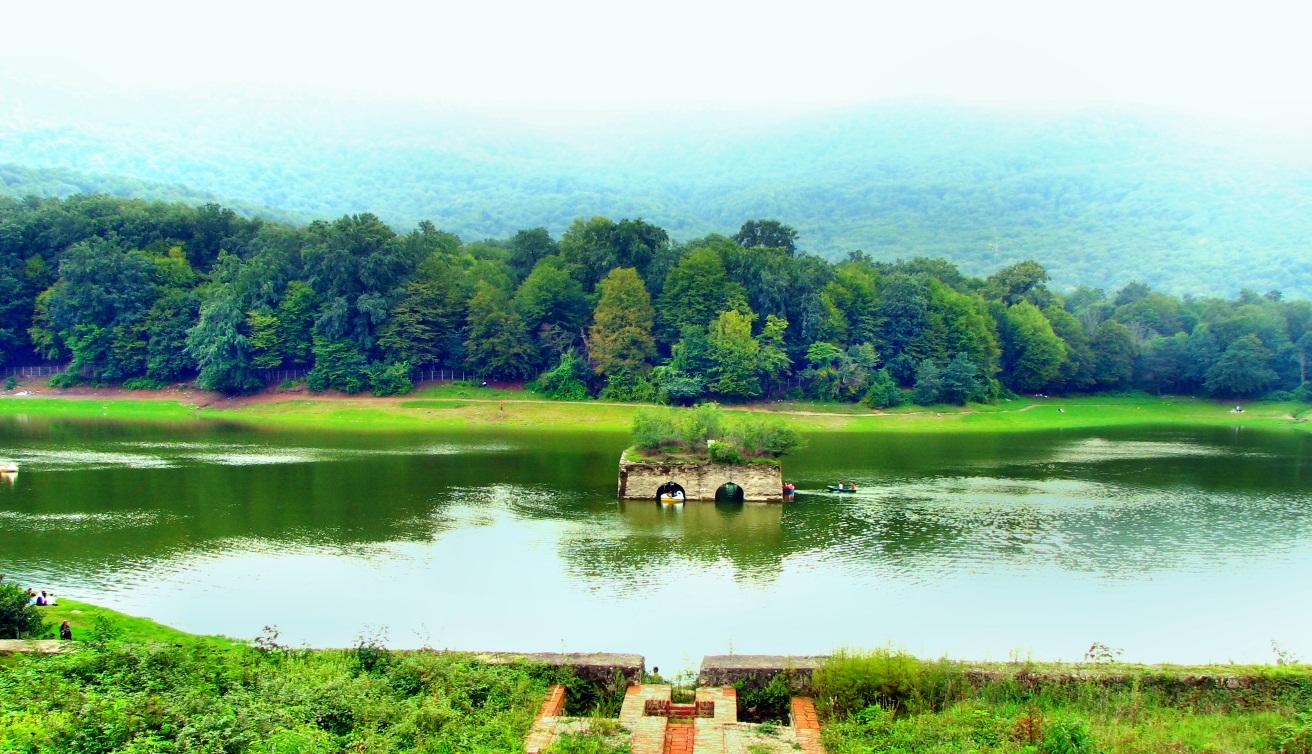
Abbasabad Garden, located in Behshahr, is a remarkable Persian garden, renowned not only for its botanical beauty but also for its extraordinary artificial lake and the distinctive chahartaq building situated in the midst of this lake. More than the garden’s flora, it is this unique combination of water engineering and architectural design that has earned Abbasabad widespread acclaim. The garden’s centerpiece, the artificial lake, was a visionary creation by Shah Abbas I, the celebrated founder of the Safavid dynasty, underlining the garden’s historical and cultural significance.
The chahartaq structure in the middle of the lake is particularly noteworthy. This building serves a dual purpose: it is an architectural marvel in its own right and functions as a spillway for the lake. The chahartaq, with its four arches, is a fine example of Safavid architectural ingenuity, seamlessly blending utility and aesthetics. Its presence in the lake not only adds a striking visual element to the garden but also demonstrates the sophisticated water management practices of the time. Built under the patronage of Shah Abbas I, Abbasabad Garden and its lake with the chahartaq spillway stand as a tribute to the Safavid era’s grandeur and its contribution to the Persian landscape.
Other World Heritage Gardens
Other World Heritage Gardens that are influenced by Persian Garden design are Alhambra in Spain, Shalimar in Pakistan and the most famous of all, Taj Mahal in India.
Conclusion
Persian garden has been source of inspiration for many artists and craftsmen, as well as writers and poets. Not only you can observe its beauty on the Persian carpets, but also can follow its trace in poetries that depict paradise on the earth.
Read More:






